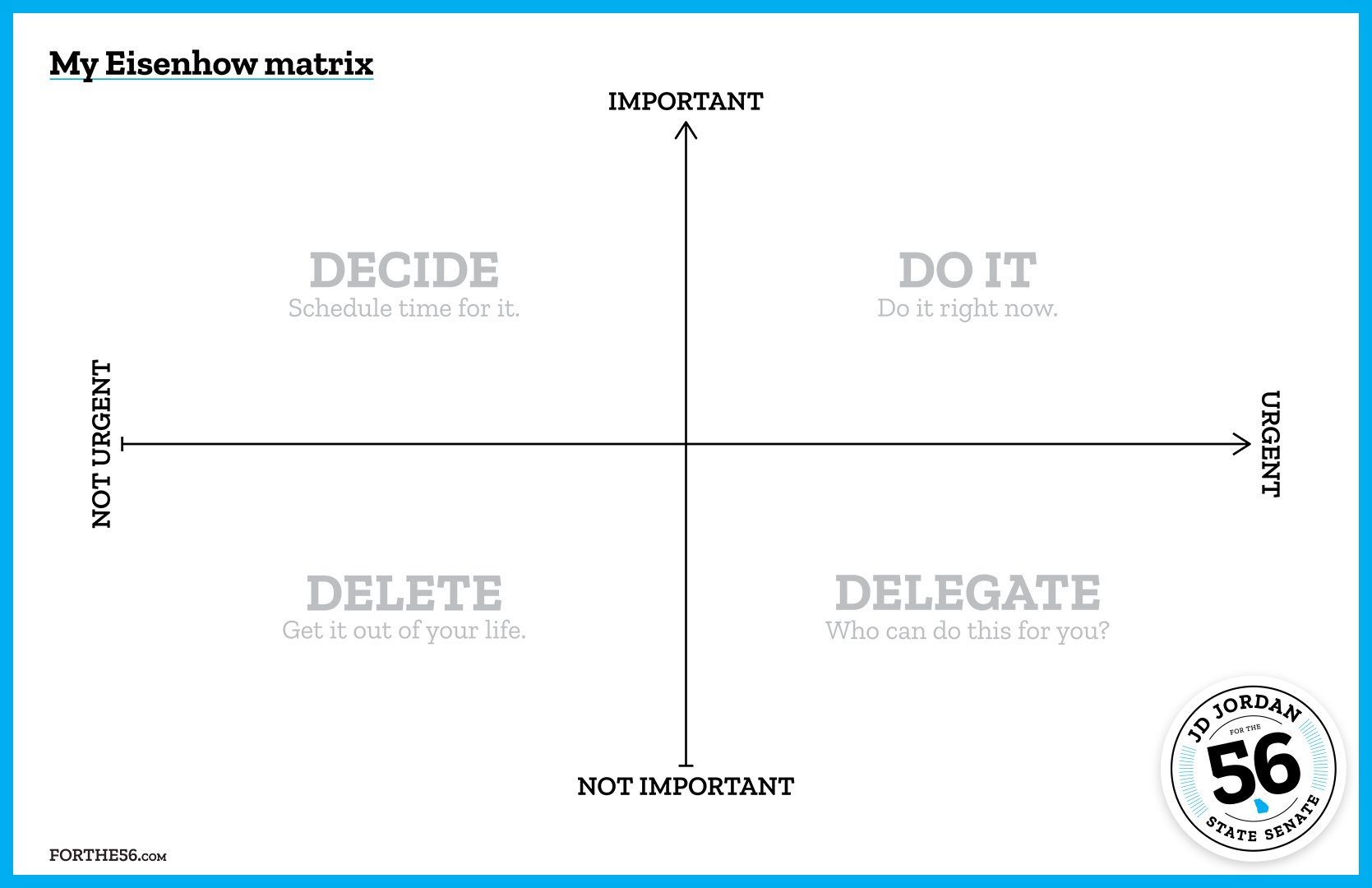Beyond resolutions: How to design your life for 2024.
Part of why I’m running for Georgia state Senate district 56 is because I believe our government can do a better job of both representing us and of delivering solutions that solve our problems. And while I may have an unconventional political, my career and experience as a product design has equipped me to bring a genuinely people-centered approach to our government.
In my day job, I use a process called “design thinking.” It’s a user-centered problem-solving process that helps businesspeople, creatives, and engineers focus on the end-user of a product by prioritizing their pain points, habits, and needs. Because if we don’t design for the user, they’ll never use our product and the project will fail.
The process is actually very simple. It’s merely the application of empathy, listening, and critical thinking without ideological bias. And, in my experience, this process works equally well for designing apps or solving parenting issues or determining government policy.
It can even help us design our lives.
So, to celebrate the New Year, I’d like to share some tips and tricks I’ve learned over the years to help you design the best possible you-centric life. Because rather than simply resolving to lose weight or change careers, you could enter 2024 armed with a plan focused on what’s most important to you and the tactics you need to get there.
Over the next few days, I’ll introduce you to four activities:
Your Life in Weeks. An audit of your past.
Eisenhower Matrix. A tool for prioritizing what’s important.
Affinity Mapping. A method for identifying what you should be doing.
Prototyping. Try it before you commit. 😁
In the process, you’ll learn something about yourself, what your needs are, how to best meet them, and how to execute a more mindful approach to your life. And you’ll get a taste for how a design-thinking approach impacts problem solving and how it might better deliver what we all need from our government.
Audit your past: Your life in weeks.
Photo by Aron Visuals on Unsplash.
The best way I’ve found to get started designing your life is to take a dispassionate look at how you’ve spent it so far. It’s one of the most eye-opening acts of introspection you can do.
Your Life in Weeks (first introduced by Tim Urban on Wait But Why) is a reflective audit of your past reduced to a graph featuring 52 boxes per row—each box representing a week, each row a year.
Download a blank Your Life in Weeks template to get started.
In its simplest form, you can fill in each box that represents a week gone by. But this audit can be so much more than a progress bar if you layer in information about the highs and lows of your past—giving yourself the information you need to design for tomorrow.
My life, circa 41. Grey is unstructured time, green is education, and blue is my career (each color in tints to represent changes in schools or employers). White dots represent positive events, black dots represent negative ones. Orange dots are opportunities I can predict. Empty dots are weeks yet lived. (Illustration by JD Jordan, who’s no longer 41 🙃).
Download a blank Your Life in Weeks template to get started.
HOW HAVE YOU SPENT YOUR LIFE SO FAR…
When were the big events in your life?
When were your kids born?
When and where did you move?
When were your major career changes or professional events?
What about relationships, weddings, or breakups?
And don’t forget major personal events: health issues, traumas, success, or other impactful life changes.
WHAT CAN YOU FORECAST…
When might your kids move out?
When might you retire?
What else can you predict?
The perspective this audit reveals can be humbling. Realizing your 40th really is your midlife might be the incentive you need for real change, knowing your kids will move out in a few years might help you re-prioritize family time, or seeing how much time you spent working on someone else’s dream might give you the motivation to start working for your own.
When I first audited myself, I was shocked by how much time I’d spent at jobs that were poor fits. I was also shocked to see how little time I had left with my kids at home. Suddenly, the pain of sitting in traffic or spending an evening away at work took on new meaning. I didn’t resent my past—what’s done is done and there’s no way to change it—but I did let it inform how I saw my present and my future.
Prioritize your present: An Eisenhower matrix.
Photo by Glenn Carstens-Peters on Unsplash.
Most of us struggle in the moment to separate what’s most important from what’s most urgent—what people expect from you, what’s fastest to complete, what does your boss need right now… Then we prioritize our schedules to match.
But can we schedule our prioritizes, instead?
An Eisenhower matrix is a simple quadrant graph that juxtaposes importance with urgency to help you identify your priorities and focus on using your time well, not just filling it.
Download a blank Eisenhower Matrix template to get started.
Start by listing everything you need to do — and everything you want to do — on individual Post-Its. Then rank how urgent or important those needs are on your typical day:
WHAT’S IMPORTANT AND URGENT?
Work deadlines
Health issues
Legal obligations
Bills and taxes
WHAT’S IMPORTANT BUT NOT URGENT?
Your partner/relationship
A dream you’re chasing
Family time
Self-care (including fitness and education)
WHAT’S URGENT BUT NOT IMPORTANT?
Most meetings
Responding to calls or messages
Unscheduled favors
Most interruptions
WHAT’S NEITHER IMPORTANT NOR URGENT
TV (even Netflix)
Social media
Excessive gaming
Work communications outside pre-defined hours (e.g., heads down time, weekends vacations)
The goal is to separate what’s important from what’s simply urgent—and to be more aware of how you spend your time and how well you spend it. Because the humbling fact is, no one else is going to prioritize what’s important to you. Your loving partner, your supportive family, your boss — they all have their own priorities that’re important to them that might not align with yours.
Identifying what your priorities are is critical to getting them into your schedule. If you want to travel or spend time with the kids or get a promotion or start a business, no one else is going to put that first. You have to. It is up to you to identify what’s important and then find time for it. And if time isn’t found for your priorities, you only have one person to blame.
Set your targets: Affinity mapping.
Photo by Nathália Rosa on Unsplash.
At this point, you probably have a lot of messy inputs about your past and your present. And a lot of thoughts about your future. It can be a lot. And if you’re designing your life in tandem with a partner, it can be even more challenging to make sense of it all.
That’s where affinity mapping comes in. It’s a powerful technique for individuals and teams to find patterns in qualitative data. We’re going to use it to determine what you want and need out of your life and to synthesize specific goals to help you make decisions that prioritize your goals and keep you on target.
I recommend affinity mapping in three easy steps:
WRITE YOUR NEEDS ON POST-ITS
Each participant takes a different colored stack of Post-it notes and writes one need per note about what they want their future to look like. Write quickly and without self-censorship. Consider:
Future needs identified in your Life in Weeks
Priority needs identified in your Eisenhower matrix,
Other wants and needs: Do you want to travel, spend more time with your partner or kids, have more money, be in better health? Write it on a post-it.
SORT ‘EM
When your notes are written, organize them by topic (e.g., family, work, habits, healtg, etc.). I find it’s best to sort notes on a window or markerboard where you can write around them with dry-erase markers and to start each category far enough apart so you have room to change things up. It doesn’t matter where you start or how you sort as long as you’re consistent.
CREATE “I/WE” STATEMENTS
When all the notes are sorted, revisit them one at a time and break them apart or combine them in new ways to support “I/we” statements. For instance, if you have a lot of notes about work life balance but only one about money, you might collect those notes under “I prioritize balance over wealth.” Pro tip: make sure no “I/we” statement is informed by fewer than three notes.
These “I/we” statements become meaningful goal targets for retrospectives and check ins to help keep you moving toward what’s important to you.
Put it together: Prototype your life.
Photo by Prateek Katyal on Unsplash.
Now that you’ve audited, prioritized, and set goals for the life you want, all that’s left is to prototype your life!
There’s no one way to do this. Maybe you only need to change one thing. Maybe you need to change everything! No change is without consequence, and your life’s requirements are different from anyone else’s.
When Ellie and I first did these exercises together, we determined we wanted to:
Work together
Spend more time together and with the kids
Start our workdays early, so we’re done when the kids come home
Not check messages outside work hours
Make time for our passion projects.
But we didn’t jump in, heedless to the impact these shifts in our habits and incomes might have on ourselves or our family. Instead, we prototyped what this new life might look like, using after-hours freelance work and hackathons to test various work-from-home habits. And we updated our prototype every week for a few months before committing—iterating on what didn’t work while keeping what did. Superficially, we designed a new work-life balance for ourselves. More deeply, though, we took control of the circumstances that let us meet our self-identified lifestyle goals.
Hopefully you’ve seen how a Your Life In Weeks audit can help you learn from your past, how an Eisenhower matrix can help you prioritize the present, and how an affinity mapping exercise for your wants and needs can help you assess if you’re making the right decisions.
It’s always a give and a take. We frequently have to go back to our affinity map results to make sure we’re still on target. Or re-prioritize with a new Eisenhower matrix. And, sometimes, the urgent overwhelms the important. C’est la vie. But always with the understanding that we are each on the hook when our lives aren’t working out the way we want. And that we have the tools and the insights necessary to fix it.
As with our lives, so too with our businesses and government. Putting people at the center of decision making—before considering ideology and polling!—will help us empathize with each other, provide consensus about our various priorities and goals, and reveal a shared road to a better Georgia.
JD JORDAN FOR GEORGIA STATE SENATE DISTRICT 56
For anyone in East Cobb, Roswell, or Woodstock alarmed by the state’s escalating attacks on our bodies, our families, our doctors’ offices, our classrooms and libraries, even our polling places, I’m running for state senate district 56 to fight for our freedoms and to deliver a better future for everyone in Georgia.
And unlike my opponent who’s spent 14 years rolling back our freedoms, failing to safeguard our kids, and gerrymandered his district to stay in office, I promise to bring everyone in the 56—regardless of ideology—the best possible constituent experience so you feel heard, valued, and supported. As we all deserve to be.
I’m running for the 56. Let’s make a better Georgia for all of us.
—
FOR MORE INFORMATION, CONTACT
Jordan For Georgia, LLC
10800 Alpharetta Hwy Ste 208 #629
Roswell, GA 30076-1467
jdjordan@forthe56.com
706.804.0456






